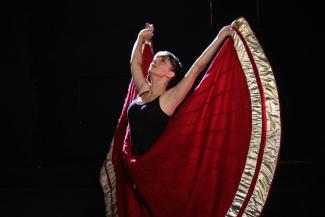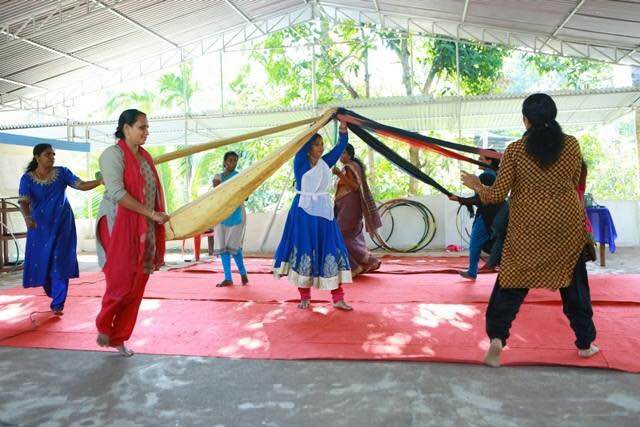
Restoring self-esteem and self-worth is what Dance Movement Therapy by Renelle Snelleksz has successfully achieved for a cross section of people like people with Parkinson’s Disease or those with a history of physical abuse and even children who have survived cancer but are deeply scarred.
What is Dance Movement Therapy? How is it different from learning Dance?
Dance Movement Therapy (DMT) is very different from technique-based dance in that it creates a safe and non-judgemental space for people to express themselves through movement. Some participants may have never had any formal training in "dance" as we know it, the difference here is that we encourage all movement as equal and respected. DMT starts with expressing through physical body movements, but as that progresses, it also addresses the emotional, cognitive and social well-being of a participant. It works to address emotional wounds that affect the day-to-day functioning of a human being. The premise is that all human memory is stored in the body and negative memories and experiences, if not released, will always manifest itself in negative ways in the person's life. We work at identifying root issues of a problem that often express itself in anger, fear, depression, suicide, low self esteem, identity issues and sexuality. Based on a needs assessment of the client/group at the start of a programme, key issues will emerge. I would then customise sessions to address these needs so that the client benefits from the process.
While dance in itself is effective in activating happy hormones in the body, like when serotonin is released it makes the individual "feel good", DMT goes a step deeper to address core issues that an individual may be struggling with emotionally.
Can you tell us in detail about the work you do with girls rescued from sex trafficking. What are the objectives?
Though I work with a number of different groups, my primary focus is to work with girls rescued from sex trafficking and other forms of sexual violence. I partner with key agencies in the anti-human trafficking field to provide an Intervention for the girls (mostly minors) through the non-threatening tool of Dance Movement Therapy. This works in sync with other rehabilitative measures implemented by these agencies.
During the rehabilitative period of 6 months to a year, these girls living in shelter homes are given restorative care. Our main objectives are to provide tools that are healing and empowering to these young lives who have experienced immense trauma to the body, mind and spirit. Core areas that we focus on include Perceptive of Self, Anger, Healing of emotional wounds, Trust, Communication, among others.
How does dance therapy help build self-esteem and emotional well being of these girls who are clearly coping with depression, anxiety, anger based on their traumatic experience?
Trauma manifests itself in negative thought processes and if there is no release for it, it will systematically destroy an individual’s life and relationships. Most girls who have experienced sexual abuse hate their own bodies and consider themselves "dirty" which is when a lot of self harm begins to take place. We work towards redeeming the body and helping the girls make a positive shift in the perception of themselves.
All this self-hatred is often manifested in raging anger. We try to give the girls tools to release their anger through strong repetitive movements and beats and then encourage them towards overcoming that anger by channeling it into something positive in their lives. The journey through dance movement therapy is always one from Negative to Positive. Through movement-based activities, the sub-conscious memories and feelings come to the surface and can then be addressed.
Read: Dancing through Self-Image Issues To Hope: A Young Woman's Alopecia Journey
How did Dance therapy help the pediatric cancer survivors?
With the children survivors of cancer, we focused on emotional healing as they had already undergone Chemo and the cancer had been physically removed from the body. But the trauma caused during the treatment period was never really addressed. One of the things that came up were Fears that were crippling them. Also, a negative perception of Self was an issue most of these children were battling. Hope for their future was something that we feel was rekindled during the DMT process.
Can you describe a couple of cases where you worked with the elderly and your observations?
It has been a privilege to work with the elderly and despite many physical limitations, its truly amazing to see them respond positively to music and movement. Even for those with physical challenges, we observed dramatic changes in their posture and reaction to melody and rhythm.
One lady was incoherent and in a wheel chair after suffering a major stroke. She did not verbally engage with anyone and her head was limp and hung lifelessly towards the back of the wheel chair. Once the music came on, we gave her a set of shakers and began to first move her hands. But to our great surprise, on her own she started rhythmically moving the shakers to the beat of the song. While she did this, her head came up and the spine was erect. She was fully present and her whole body language changed. We found out later, that she was a music teacher by profession and so instantly there was such a beautiful connect to the sound of music.
Another elderly lady who had Parkinson's and was experiencing very intense shaking also began to respond when the music came on. Once the shakers came to her, she stood up from her seat and held the shakers above her head and was dancing and twirling around like a little child. The shaking stopped and she had full control of her body and its movements during this time and the joy communicated simply from her dance was something the group had not seen before. She explained later that her heart was so happy that day.
Related Reading: Kathak Dance Aids Mobility in Parkinsons and Arthritis Patients
DMT eases up Parkinson’s patients and helps them dance to music . DMT also helps people who have been sexually abused release their pent up anger and frustrations through dance movements. Are both the releases triggered by similar therapy wth varying results? Or is there a more intricate methodology here?
The DMT methodology for each group will be customised according to the needs of that group. In this case, with Parkinson's patients, the application of movements such as rhythms and beats were introduced along with simple percussion instruments like shakers and tambourines. It was observed that the participants were able to match movements with the facilitator and as they followed the rhythm it was found that the intense uncontrollable shaking was dramatically reduced. They gained more control over their movements and this in turn impacted their emotions. Instead of a posture of despair, they responded with joy and enthusiasm. The emphasis here was on the physical and that in turn altered their mood.
In contrast to this, when working with girls who have been trafficked the approach is very different because the needs are different. Here the emphasis is more on the emotions and the emotional wounds of the participants. So the movements are used as a tool for the release of certain negative emotions like anger, depression and emotional pain. So while we also begin with movements, we use it primarily to tap deeper issues that are difficult to verbalise and so dance becomes a safe way to address those core issues that are affecting the individual.
Are there other situations where you think dance therapy would be useful?
DMT can be applied to varied situations and people groups. In the US, it is usually used at a clinical level in hospitals to treat Parkinson's, Alzheimer's and Cancer survivors among others. But what is really interesting is that in India it is being widely used not just at the clinical level but with children with special needs, mental health institutions, the elderly, survivors of sexual violence, mainstream population and corporate settings as a tool to distress.
Related Reading: Dance and Art Therapy For Cancer Survivors
What would you say to people who are not sure if dance therapy is appropriate for them?
DMT works hand in hand with other therapies like counselling and can be applied to a variety of situations. I have had participants come to me and say they have two left feet and have never danced in their lives. I always encourage them to participate to the extent that they are comfortable and they have always had a favourable experience. DMT is powerful to the extent that a participant is willing to be open to the process and methodology. It is safe and non-threatening and leaves room for an individual to gradually get comfortable. The nature of art and self expression is powerfully therapeutic because it accesses the deepest part of the human spirit and brings healing to wounds that cannot otherwise be expressed. I would encourage people to first experience the process and then decide if they would like to consider exploring it.
What is the simplest way for someone to get started on dance movement therapy?
Find a practitioner in your city and if the objectives being addressed in their sessions are areas that you would like to personally explore as well, then sign up for these sessions.








